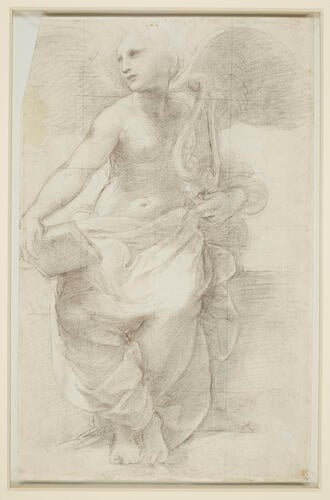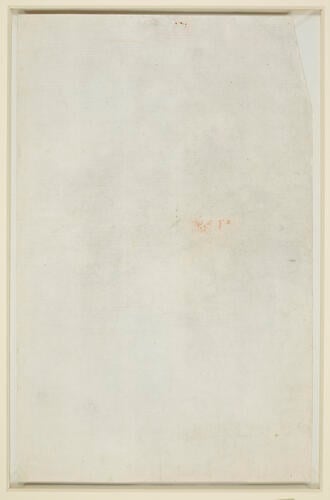-
1 of 253523 objects
A personification of Poetry c.1509
Black chalk over stylus underdrawing, squared in black chalk. Watermark of a mermaid in a circle. | 35.9 x 22.7 cm (sheet of paper) | RCIN 912734
-
A study for the figure of Poetry, one of four circular frescoes by Raphael in the vault of the Stanza della Segnatura in the Vatican Palace.
The decoration of the Segnatura for Pope Julius II was Raphael's first major undertaking in Rome. The frescoes on the four sides of the room are on the themes of Theology, Philosophy, Jurisprudence and Poetry, and together with the layout of the room, and the absence of any other room whose decorations would conform to such a use, iindicate that the Segnatura was occupied by Julius's library.
The project was apparently begun under the direction of the artist Sodoma before the arrival in Rome of Raphael, who is first documented there (in a payment for work for the Pope) on 13 January 1509. It seems likely that Raphael began work in the Stanza as a collaborator of Sodoma, who was probably responsible for the elaborate layout of the vault, and for painting the central octagon, and four pairs of small scenes that were soon destroyed to make way for rectangular scenes by Raphael. Though the chronology of the paintings has been disputed, Raphael probably first painted the four circular frescoes of personifications in the vault, and was then given responsibility for whole scheme after demonstrating his technical ability and pictorial intelligence in those figures. The principal frescoes on three of the walls depict an assemblage of protagonists of the relevant discipline: for Theology, the Disputa, representing divine knowledge and thus set against an open sky (see RCIN 912732-3); for Philosophy, the School of Athens, representing human knowledge and thus against pure architecture; and for Poetry, Mount Parnassus (see RCIN 912760). The Jurisprudence wall – interrupted by a large window – was divided into three: a lunette of Fortitude, Prudence and Temperance and, either side of the window, Pope Gregory IX delivering the Decretals and Justinian proclaiming the Pandects. Monochrome frescoes in the window embrasures completed Raphael's decorations (see RCIN 903720).
The pose and lower drapery in the present drawing agree almost exactly with the figure as painted, but here she is nude to the waist. The fluid stylus underdrawing shows the figure sketched out as fully nude, to capture the proportions and pose of the legs rather than as a first idea for the figure. The tilt and accoutrements of her head are also different; despite squaring that might suggest that the present drawing was enlarged to a full-size cartoon, these adjustments were probably not improvised at full scale, for an engraving by Marcantonio Raimondi (Bartsch 382) records a lost study still closer to the final design. A drawing in the Louvre (Cordellier and Py, Raphael, son atelier, ses copistes, 1992, no. 86) has been published as a study for the head of the figure, but it is weak and hard to reconcile with Raphael's incisive work at this time, and appears rather to be a copy; the drawing on the verso of that sheet does not support an attribution to Raphael.
In his biography of Raphael (1568), Giorgio Vasari called the present figure Polyhymnia, sometimes identified as the muse of lyric poetry, which would accord with the lyre held by the figure; but in his Life of Marcantonio Raimondi, Vasari called her Calliope, the muse of epic poetry (Vasari, Vite de’ pittori… 1568, II, pp. 70, 300). The Muses had no stable iconography and their domains depend on the source consulted; the phrase NUMINE AFFLATUR (‘divine inspiration’) on the tablets held by flanking putti in the painting could apply to any of the Muses, and indeed to the Parnassus as a whole, in which all branches of poetry are represented. It is thus most probable that she was intended simply to be a non-specific figure of Poetry.
George III's 'Inventory A' of c.1810 listed nearly all the drawings by Raphael in the Royal Collection in a single album entitled Raffaello d’Urbino e Scuola. The Italian title may suggest that the whole album had an Italian origin, but several drawings in the album had evidently been inherited by George III rather than purchased. The 'Inventory A' of c.1810 states of the study of Poetry, ‘This is from Kensington’, a comment expanded in an entry on another sheet, The Miraculous Draft of Fishes (RCIN 912749): ‘This Drawing was found in an Old Bureau at Kensington which contained part of the Collection of King Charles ye first, where also was preserved the Volume of Leonardo da Vinci’ - though it is much more likely that those albums had been assembled by Charles II than by his father.
Provenance
Probably acquired by Charles II; Royal Collection by c.1810 (Inventory A, p. 49).
-
Creator(s)
(artist)Acquirer(s)
-
Medium and techniques
Black chalk over stylus underdrawing, squared in black chalk. Watermark of a mermaid in a circle.
Measurements
35.9 x 22.7 cm (sheet of paper)
Other number(s)

